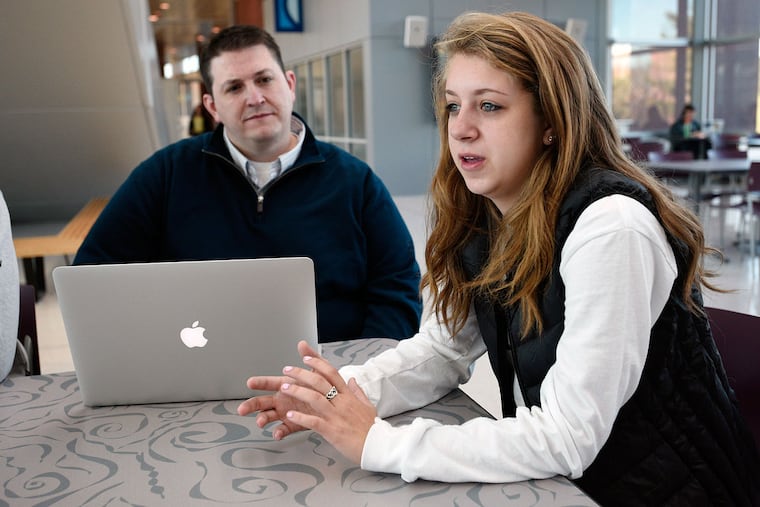Penn State imagines a world where robots write the books
The class assignment - write a textbook - took Michael Anselmo 40 minutes. The Pennsylvania State University senior had some help.

The class assignment - write a textbook - took Michael Anselmo 40 minutes.
The Pennsylvania State University senior had some help.
From robots.
At Penn State, educators have designed a new technology called BBookX to build textbooks using open resources on the Web - right now, primarily Wikipedia.
Faculty help the robots - which are virtual spiders that crawl across the Internet, searching for information - by typing in topics and key words of interest. The system quickly returns information, which the authors can blend with other entries or infuse with content of their own.
"The idea is that this is an intelligent system that is really learning from how people interact with it," said Kyle Bowen, Penn State's director of education technology services, and part of a team that created the system.
The robots, he said, work the way Netflix does as it keys in on movies a person may like based on those previously watched, he said.
Bowen said the team's ambition was to build textbooks that can be updated regularly, and develop texts on highly specialized topics for which there are none and save students money.
The technology, he said, is still early in development, and is likely most useful in computer science and other areas where information changes rapidly.
Barton Pursel, faculty programs coordinator, piloted the technology to create a 16-chapter text for his Information, People, and Technology class. His effort saved his students a total of $16,000 in textbooks.
"That's the best part," said Anselmo, who spends $500 a semester on books.
Pursel asked students to use the technology to create their own three-chapter, nine-page book on a topic in their field.
Anselmo, 21, a finance major from Pittsburgh, chose high-speed trading.
"It took me a little bit to get used to it," Anselmo said. "I didn't like my results, so I entered new keywords. By about the third round, I had a makeshift textbook that was easy to use, and you could learn something from it."
His experience taught him that he's at a real disadvantage trading stocks without the technology that allows traders to buy and sell millions of shares in a split second.
More than two thirds of the students in Pursel's class said they learned something new about their field through the exercise, Pursel said.
Bowen, Pursel, and C. Lee Giles, professor of information sciences and technology, said they have received largely positive responses to their work.
"Probably some of the only negative questions or comments we got was this idea that 'How can a robot accurately write a textbook?' " Pursel said. "We very quickly say it's not just the computer. . . . We actually do the vetting of the quality."
Gene Foreman, a retired Penn State journalism professor who has written a textbook - The Ethical Journalist - said he'd have to be shown that the technology could produce a textbook of the same high quality as a human.
"I could see a program like this saving me a lot of time gathering raw material," said Foreman, who managed The Inquirer's newsroom operations for more than 25 years. "I'm not sure I would be satisfied with taking that raw material and somehow synthesizing a chapter of a textbook. That's where I think the human brain has to come into play."
Foreman said that preparing his book, which came out in 2009, required gathering lots of information from varied sources and putting it together in a way that is logical and appeals to a student reader, much in the same way as a news story.
Lindsay Diamond, 19, a sophomore marketing major from Paramus, N.J., raised a similar concern.
"I think the main problem with this book is that there is so much information on each concept, but the concepts aren't linked together," she said of the book she created for class.
Darrell West, director for technology innovation at the Brookings Institution, said the educators' project has merit.
"It's good that we're figuring out how to use robots to make our lives easier. There are tasks they can do very well and that free humans for more creative enterprises," he said, alluding to the Associated Press' "Statsmonkey," which writes basic stories based on box scores and play-by-play information.
Wikipedia has faced criticism for inaccuracies, but West said the information source has proven reliable for most topics - particularly in technical subjects.
"If a topic is contentious or there are contested facts, those subjects are more difficult," he said. "You need areas where there is a right answer."
The Penn State educators agreed.
"It's going to be stronger in really structured knowledge areas like science, engineering, math," Giles said.
The team's next step is to add other open information resources to BBookX so it won't rely solely on Wikipedia.
It was Giles who spurred the project. He became frustrated with trying to compile texts on his own without a program.
"I'd rather have an algorithm do it," he said.
The educators plan to expand the pilot to other professors and students. Graduate students have had papers published on the project, and a doctoral student will do her dissertation on it.
"I describe this as a moon shot," Bowen said. "We can teach a machine. When we say a topic, it can understand what we mean by that. Now comes the point of getting it to repackage that material to fit how a professor wants to teach a class or how it is their students may be most interested in that material. This is step one of a lot of steps."
ssnyder@phillynews.com215-854-4693
@ssnyderinq